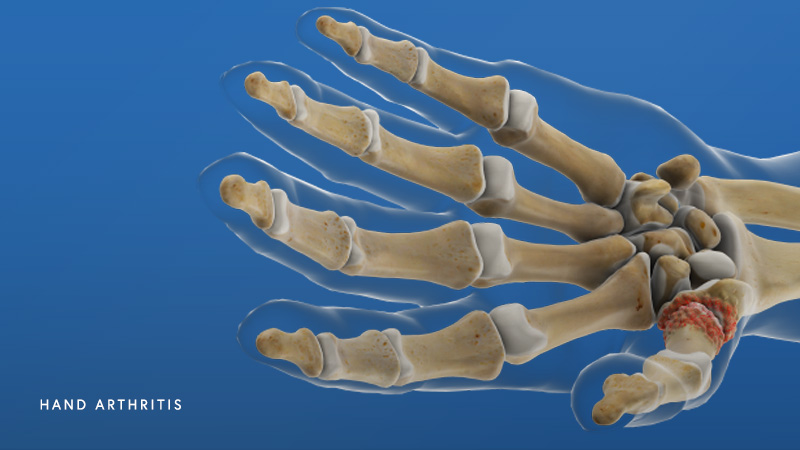Hand Arthritis
Arthritis is the swelling or tenderness of one or more of the body’s joints. As it pertains to the hand, arthritis is a disease that attacks the tissues of the base of the thumb, the knuckles, and the second and top joint of the fingers.
The hand is made up of a variety of bones, muscles, and ligaments that allow for movement and dexterity. There are three major bones found in the hand: the phalanges, metacarpal bones, and carpal bones. The phalanges consist of the 14 bones that are found in the fingers of each hand. Each finger has three phalanges while each thumb only has two. The metacarpal bones are five bones that compose the middle part of the hand. The carpal bones are the eight bones that create the wrist and are attached to the ulna and radius bones.
There are many tendons, ligaments, muscles, and sheaths that can be found within the hand. The muscles of the hand are the structures that have the ability to contract, which allows movement of the bones in the hand. The ligaments are fibrous tissues which aid in binding together the joints in the hand. The sheaths are tubular structures that surround the ends of the extensor tendons in the fingers. The tendons connect muscles in the hand to the bone, thus allowing movement.
Arthritis attacks the lining of the joints of the hand and the cartilage (the smooth covering at the ends of the bones). Eventually, the cartilage will break down and the ends of the bones become exposed and rub against each other and wear thin or waste away entirely. There are three different types of arthritis that can affect the hand:

Rheumatoid Arthritis
This type of arthritis is a chronic inflammatory disease that causes the lining of the joints to swell. This swelling and inflammation can cause pain, stiffness, and loss of function. Rheumatoid arthritis is an auto-immune disease where the immune system attacks its own tissue.
Osteoarthritis
This degenerative form of arthritis is also the most common form of arthritis. Osteoarthritis causes the cartilage of the bones to break down and wear away. This form of arthritis most commonly affects the wrist, joint at the base of the thumb, and the middle and top joints of the fingers.
Psoriatic Arthritis
Psoriatic arthritis affects the skin and joints of the hand. The fingers often become swollen, and joint pain and morning stiffness are common effects as well. Psoriatic arthritis is very similar to rheumatoid arthritis.
There are many risk factors associated with hand arthritis. While a direct cause of the various types of the disease is unknown, there are many factors that make individuals more at risk than others. These risk factors include:
- Obesity – Having excess weight in the body puts extra stress on joints especially in the hips, knees and spine. Those who are overweight are more susceptible to getting arthritis.
- Age – The risk of getting one of the various forms of arthritis has been proven to increase with age.
- Sex – Women are more likely to develop rehumatoid arthritis than men. Men are more likely to develop gout, which is another form of arthritis as well.
- Previous Joint Injury – People who have injured a particular joint, especially in a sport that is a repeated activity, are more likely to develop arthritis in that joint.
- Family History – Arthritis has been proven to be genetic. Genes can make an individual more likely to develop arthritis based on environmental factors.
The most common symptoms of arthritis occur in the joints. Depending on the type of arthritis, symptoms may include:
- Decreased range of motion
- Dull or burning pain in the joints that develops into sharp pain
- Redness
- Swelling in the hands
- Morning stiffness and pain
- Grinding or cracking in the fingers
During a physical exam, the physician will test the affected area(s) for swelling, redness, pain, warmth, and range of motion. Drawing fluid is a common practice used by physicians in order to determine the type of arthritis present in the hands. Bloodwork, urine, and joint fluid are often tested.
In addition, imaging tests are often done that can detect problems within the joint that are causing symptoms to arise. XRays, CT scans, MRIs, and ultrasounds reveal loss of bone cartilage and the formation of bone spurs that are directly associated with hand arthritis.
The goal of treating hand arthritis is to reveal the areas of joint pain and improve the function of the affected joints. Splints and braces are commonly used to support and protect the affected joint(s). Splints and braces also reduce deformities, provide stability in the joint(s), lessen strain on the joint(s), and promote proper joint alignment. Medications and surgeries are often the next course of action.
Medications
Commonly used medications vary depending on the type of arthritis in the hand. Medications that are often recommended include:
- Painkillers
- Non-steroidal anti-inflammatory drugs (NSAIDs)
- Counterirritants
- Disease-modifying antirheumatic drugs (DMARDs)
- Corticosteroids
- Biologic response modifiers
- Acetaminophen
- Immunosuppressive drugs
Surgery
Surgery is a recommended course of action if symptoms do not improve when undergoing the aforementioned treatment options. The physician may recommend surgeries such as:
- Joint repair
- Joint replacement
- Joint fusion
If you or a loved one are currently experiencing the symptoms regarding any of the types of arthritis found in the hand, contact a medical professional immediately. The Center for Orthopaedic Specialists have been providing those affected with arthritis in California with treatment plans for years. Contact the Center for Orthopaedic Specialists today to see which treatment plan will work for you!




 / 50 Reviews
/ 50 Reviews